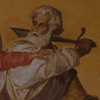

 |
 |
 |
|
The Bible as ImageAn Interpretation of Gravestone Carvings at St Gwenog’s Church, Llanwenog, CeredigionAs might be expected, most if not all of the surviving gravestones in the churchyard date from the last three hundred years.(1) The now extremely common use of an inscribed headstone as a commemorative monument largely dates from this period.(2) It was greatly encouraged in the nineteenth century by what Frederick Burgess described as “the Victorian etiquette of piety, which encouraged commemoration as a social obligation”.(3) Many of the gravestones of the first half of the nineteenth century illustrate the popularity in artistic and architectural taste of what has been termed the Greek Revival, with the deployment of classical motifs, such as the draped urn and fan-patterns. The style of inscriptions, too, changed during this period, from the freehand and flowing calligraphic to the more rigid and regular typographic. By mid-century, the classical was, in its turn, giving way to the Gothic Revival, with an increasing use of crosses, pinnacles, and the lancet-shaped headstone.
One emblem or motif which appears on gravestones from the late eighteenth century onwards, and which can, for example, be seen on a number of headstones in the churchyard at Llanwenog, is the book; the Bible itself used as an image. In the majority of cases, the book is closed.(4) The question needs to be asked, “what is the significance of this image?” Burgess indicates that the emblem has “several shades of meaning”, including prayer, knowledge and memory.(5) His interpretation is too superficial. History and local context may well reveal deeper shades of meaning and significance. It is well to remember that, for example, rural churchyards such as Llanwenog were parochial burial grounds, the use of which was not restricted to members of the Established Church. The balance of probability is that, by the date most of these headstones were erected, the families responsible were dissenters, members of one or other of the nonconformist denominations, such as that which had its origins and roots in Ceredigion, Welsh Calvinistic Methodism. More research would be needed to ascertain whether those commemorated on these headstones were ‘church’ or ‘chapel’, but it is more than likely that at least some were of the latter.
Then, the date of many of these headstones with their closed-Bible emblem is of significance. That, for example, of Evan Evans, Brynllofawr, is 1859, and that for Jenkin Morgan, Cwmnant Hall, is 1907. Between them, these dates span the years of Welsh nonconformity’s greatest strength and influence; the years between the Great Revival and that of Evan Roberts, which swept through the religious life of Wales. They also embrace, as John Harvey has pointed out,(6) the period in which Welsh nonconformity first accepted, and then developed and encouraged, the use of art and ornamentation. “Godly and edifying decoration” inside the chapel and without, became acceptable,(7) and what could be more acceptable than an image of the Bible itself?
The placing of this image on the gravestone of an identified individual was both a personal testimony and an instrument of evangelism. A myriad of scriptural quotations, a positive catena, can be found to illustrate this. Seven examples will suffice here.
This last example is particularly appropriate for a gravestone; the mute testimony of one who has “died in the Lord”, and now rests in confident expectation of the final judgement. The Bible, containing in itself, all these testimonies (and, of course, countless numbers of others), thus becomes, in the image of the book, a treasure-chest of teaching and assurance, and a witness to itself.
This is not to say that any or all of these particular texts were in the minds of those who erected these headstones. However, in a Bible-reading age, all would have been familiar to them, and would have been interpreted with a personal application.(8) The words of 1 Peter 1 verse 23, “For you have been born again, not of perishable seed, but of imperishable, through the living and enduring word of God” would have been an assurance very much taken to heart. In this period, 1859–1907, texts such as these, emphasizing conversion, self-surrender, trust, faith and hope, would have been uppermost in the minds of those responsible for erecting headstones such as those at Llanwenog. The image of the Bible thus can be seen to be more than just pious decoration; it stood emblematically for the life and beliefs of those commemorated on the stone itself. John Morgan-Guy Church of St Gwenog, Llanwenog
1. There is a useful introductory essay on the origins and development of churchyards and cemeteries in Frederick Burgess, English Churchyard Memorials (London, SPCK 1963) pp 17-59. 2. This is not to say that such did not exist before the eighteenth century. It is more likely that earlier examples were of wood, and have perished. Op.cit. p.116. It is also worth bearing in mind that for many centuries burial sites within churchyards were re-used; thus the idea of a permanent memorial on a permanent grave would have been an unusual one. 3. Ibid. p.115. It is worth pointing out that this selfsame “etiquette of piety” also gave a considerable boost to the manufacture and erection of stained glass windows. 4. The open book does occasionally appear — as it does on churchyard memorials of earlier date, eg the early eighteenth century. 6. John Harvey, The Art of Piety. The Visual Culture of Welsh Nonconformity (Cardiff, Univ.of Wales Press, 1995) p.24. 8. All of the chosen examples have been taken from the Old Testament, where their context is, of course, the chosen and elect people of God. Certainly Welsh nonconformists would have seen themselves as the heirs of this promise, and such texts as these would have had a direct and personal relevance. |
 Gravestone of Jenkin Morgan, c.1907, Church of St Gwenog, Llanwenog |




